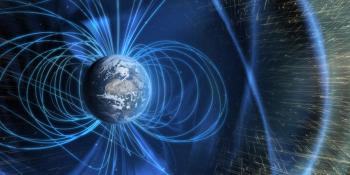Vaata reede, 4 veebruar 2005 arhiivi
Päikese aktiivsuse aruanne
Any mentioned solar flare in this report has a scaling factor applied by the Space Weather Prediction Center (SWPC). Because of the SWPC scaling factor, solar flares are reported as 42% smaller than for the science quality data. The scaling factor has been removed from our archived solar flare data to reflect the true physical units.
Päikese ja geofüüsikalise aktiivsuse aruanne 2005 Feb 04 2200 UTCValminud NOAA © SWPC ja töödeldud SpaceWeatherLive.com-iga
Ühine USAF / NOAA päikese- ja geofüüsikaalase aktiivsuse aruanne
SDF number 035 Välja antud 2200Z kuni 04 Feb 2005IA. Päikese aktiivsete piirkondade ja päikeseaktiivsuse analüüs alates 03-2100Z kuni 04-2100Z Solar activity was low. A single C1 flare occurred at
04/1509Z from a source on the east limb near N14. This is likely the
return of old Region 720 (N13, L=178), which produced several major
flares during its previous transit across the visible disk. Several
brightenings near the northeast limb suggest this region is still
quite active. A CME at 04/0731Z occurred in association with a
prominence eruption from the northeast limb. The CME does not appear
to be Earth directed. New Region 730 (S20E73) was numbered today and
produced occasional B-class flares.
IB. Päikese aktiivsuse ennustus
Solar activity is expected to be low
to moderate. The probability for M-class activty will increase
following the return of old Region 720 on 05 February.
IIA. Summaarne geofüüsikaline aktiivsus 03-2100Z kuni 04-2100Z
The geomagnetic field was quiet. Solar wind speed began the period at
over 500 km/s, but gradually decreased to near 430 km/s. The greater
than 2 MeV electron flux at geosynchronous orbit was at high levels
again today.
IIB. Geofüüsikalise aktiivsuse ennustus
The geomagnetic field is
expected to be predominantly quiet with occasional unsettled periods
on 05 and 06 February. A coronal hole high speed stream is expected
to rotate into geoeffective position on 07 February and induce
occasional active periods.
III. Sündmuste tõenäosus 05 Febkuni 07 Feb
| Klass M | 15% | 25% | 25% |
| Klass X | 05% | 05% | 05% |
| Prooton | 01% | 01% | 01% |
| PCAF | green | ||
IV. Pikklaine 10.7 cm kiirgus
Vaadeldud 04 Feb 082 Prognoositud 05 Feb-07 Feb 090/100/115 90 päeva keskmine 04 Feb 100
V. Geomagneetiline A-indeks
Vaadeldud Afr/Ap 03 Feb 005/008 Hinnanguline Afr/Ap 04 Feb 005/004 Prognoositud Afr/Ap 05 Feb-07 Feb 005/005-005/005-010/015
VI. Geomagnetilised aktiivsuse tõenäosused 05 Feb kuni 07 Feb
| A. Keskmistel laiuskraadidel | |||
|---|---|---|---|
| Aktiivne | 10% | 10% | 25% |
| Väike torm | 01% | 01% | 10% |
| Suur-tõsine torm | 01% | 01% | 01% |
| B. Kõrgetel laiuskraadidel | |||
|---|---|---|---|
| Aktiivne | 15% | 15% | 40% |
| Väike torm | 05% | 05% | 20% |
| Suur-tõsine torm | 01% | 01% | 05% |
<< Mine igapäevase ülevaate lehele
Viimane uudis
Viimane foorumi postitus
Aurora scatter? 2Geomagnetic storming, CMEs from AR 13664, 2024-05-09/10 1053AR3664 775Is there any truth to this "Internet/Electrical Grid Apocalypse"? 142Sporadic E and Flare activity 29
Veel teemasidToeta SpaceWeatherLive.com-i!
Paljud inimesed külastavad SpaceWeatherLive lehte selleks, et jälgida, mis toimub Päikesel või, kas on oodata virmalisi. Suurema liiklusega on serveri koormus ning maksumus kõrgem. Kui sulle meeldib see, mida me sinu heaks teeme, siis saad sa sellele ka ise natukene kaasa aidata, annetades selle lehe käigus hoidmise ja arendamise heaks. Ette tänades SpeaceWeatherLive meeskond!

Fakte kosmose ilmast
| Viimane X-loide | 11/05/2024 | X5.7 |
| Viimane M-loide | 10/05/2024 | M3.7 |
| Viimane geomagnetiline torm | 10/05/2024 | Kp9 (G5) |
| Plekivabasid päevi | |
|---|---|
| Viimane päikese plekivaba päev | 08/06/2022 |
| Kuu keskmine päikeseplekkide arv | |
|---|---|
| aprill 2024 | 136.5 +31.6 |
| mai 2024 | 139.8 +3.3 |
| Viimased 30 päeva | 170.5 +79.6 |


